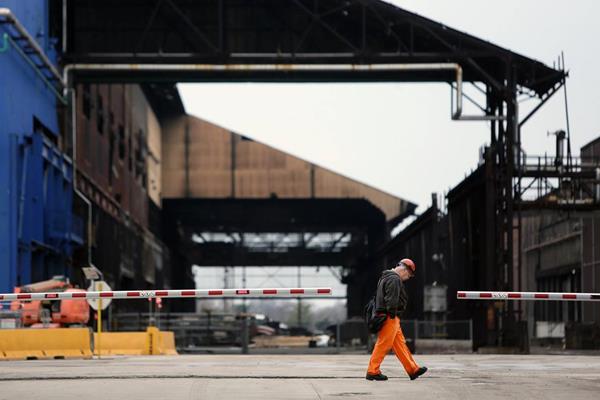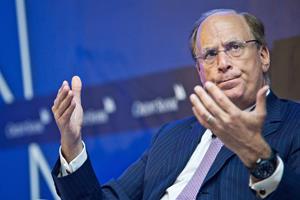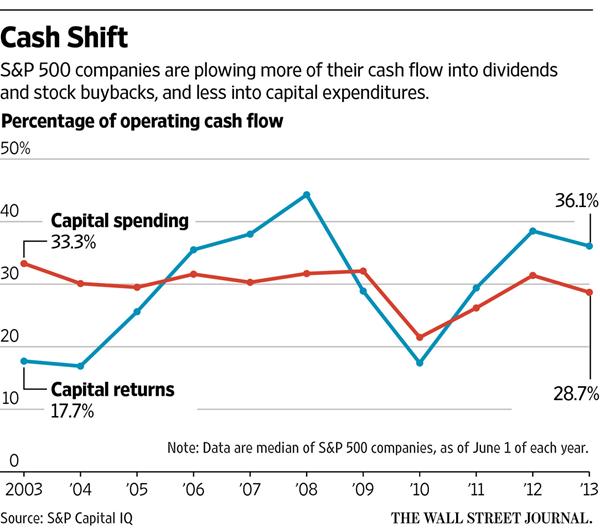|
THE
WALL STREET JOURNAL.
Markets
Companies Send More Cash Back to Shareholders
Activists
push for returns, fueling worries about long-term investment
|

Every proposed project at U.S. Steel, whose Granite City, Ill.,
plant is shown in March, must be linked to the value it could
create for shareholders. PHOTO: HUY MACH/ST. LOUIS
POST-DISPATCH/ASSOCIATED PRESS |
By
Vipal Monga,
David Benoit
and
Theo Francis
May 26, 2015 10:30 p.m. ET
U.S. businesses, feeling
heat from activist investors, are slashing long-term spending and
returning billions of dollars to shareholders, a fundamental shift in
the way they are deploying capital.
Data show a broad array of
companies have been plowing more cash into dividends and stock
buybacks, while spending less on investments such as new factories and
research and development.
Activist investors have
been pushing for such changes, but it isn’t just their target
companies that are shifting gears. More businesses sitting on large
piles of extra cash are deciding to satisfy investors by giving some
of it back. Rock-bottom interest rates have made it cheap to borrow to
buy back shares, which can boost a company’s stock price. And
technology-driven productivity gains are enabling some businesses to
do more with less.
As the trend picks up
steam, so too has debate about whether activist investors—who take
sizable stakes in companies, then agitate for changes they think will
boost share prices—have caused companies to tilt too far toward
short-term rewards.
Laurence Fink,
chief executive of
BlackRock Inc.,
the world’s largest money manager, argued
as much in a March 31 letter to S&P 500 CEOs. “More and more corporate
leaders have responded with actions that can deliver immediate returns
to shareholders, such as buybacks or dividend increases, while
underinvesting in innovation, skilled workforces or essential capital
expenditures necessary to sustain long-term growth.”
|

Photo: Sam Kang Li/Bloomberg News
‘While delivering immediate shareholder returns, executives are
‘underinvesting in innovation, skilled workforces or essential
capital expenditures necessary to sustain long-term growth.’
—Laurence Fink, CEO Blackrock Inc.

Photo: Victor J. Blue/Bloomberg News
‘With many, many exceptions, this economy today is being dragged
down by too many mediocre CEOs.’
—Carl Icahn, activist investor
|
|
An analysis conducted for
The Wall Street Journal by S&P Capital IQ shows that companies in the
S&P 500 index sharply increased their spending on dividends and
buybacks to a median 36% of operating cash flow in 2013, from 18% in
2003. Over that same decade, those companies cut spending on plants
and equipment to 29% of operating cash flow, from 33% in 2003.
At S&P 500 companies
targeted by activists, the spending cuts were more dramatic. Targeted
companies reduced capital expenditures in the five years after
activists bought their shares to 29% of operating cash flow, from 42%
the year before, the Capital IQ analysis shows. Those companies
boosted spending on dividends and buybacks to 37% of operating cash
flow in the first year after being approached, from 22% in the year
before.
Dividend
boost
While billion-dollar stock buybacks draw
headlines, dividend increases also are a big factor, according to data
from
Moody’s Investors Service.
At the 400 nonfinancial U.S. companies
that Moody’s rates as investment grade, the median percentage of cash
spent on dividends rose to 11.9% of earnings before interest, taxes,
depreciation and amortization, or Ebitda, in the third quarter of last
year, from 9.4% in 2013, to the highest percentage since at least
2005.
Companies ranging from the industrial
conglomerate
DuPont Co.
to
Apple Inc.
are sending more of their cash to their
shareholders after coming under pressure from activists.
General Motors Co.
announced a $5 billion stock
buyback in March after investor Harry
Wilson and four hedge funds called on the company to return cash to
shareholders.
It is it too early to know
how—or whether—the shift will affect the overall economy.
Some economists predict an
investment reduction will mean less growth and fewer jobs. “If
investment falls, then you’re losing demand in the economy, you’re
losing expenditures, you’re losing economic stimulus,” says Steven
Fazzari, an economist at Washington University. “That’s hurting jobs.”
Other economists say it is
appropriate for companies to focus on enriching shareholders, who can
then decide where to deploy the money. To the extent buybacks and
higher dividends push up stock prices, they can contribute to what
economists call the wealth effect, where rising asset prices make
consumers feel wealthier and more confident about spending their
money.
Hedge funds run by
activist investors contend companies waste a lot of money that they
should send to shareholders instead. One such investor, Carl Icahn,
says activism with a long-term focus improves the economy by promoting
efficient use of capital. “With many, many exceptions, this economy
today is being dragged down by too many mediocre CEOs, and it’s
dangerous if profitability is going down despite interest rates being
at zero,” he says.
Business investment ticked
up in April but remains sluggish and uneven. In recent years,
corporate investment in capital goods, beyond replacing and
maintaining existing assets, has grown slowly. While falling
technology costs may account for some of the trend, companies have
been slow to return to higher investment levels since the financial
crisis. “One could argue that this has not been a good recovery for
investment,” says Christopher Probyn, chief economist for State Street
Global Advisors.
Capital spending by
businesses accounts for about one-eighth of all spending in the U.S.
economy. Historically, it has been an important driver of long-term
growth, as upgrades make workers and companies more productive, says
Michael Feroli, chief U.S. economist at
J.P. Morgan Chase
& Co.
Money plowed into
dividends and buybacks doesn’t disappear from the economy. Its
recipients can spend it, too.
But Washington
University’s Mr. Fazzari says that most stock is owned by the wealthy,
who tend to save more of their income. By contrast, he says, many
kinds of business investment—from building construction to equipment
maintenance and purchases—involve payments to contractors and
suppliers who pay wages to middle and low-income workers.
Many companies have made changes while
under no direct threat from activists.
General Electric Co.
’s institutional investors had long urged
the conglomerate to scale down its large lending business. In April,
GE said it would sell off that business
and buy back $50 billion of its stock.
The company said it chose
to plow the proceeds into buybacks because it already had made
substantial acquisitions and has invested sufficiently in its existing
businesses.
U.S. Steel
Corp. buying back stock. But Chief Executive Mario Longhi has imposed
a new analytical framework under which every proposed project must be
linked to the value it could create for shareholders. The more
disciplined approach sets a higher bar for R&D, which used to get a
green light if it could simply boost production, says Mr. Longhi.
U.S. Steel is under
pressure from cheaper imported steel and has a high cost structure
because its blast furnaces are expensive to turn on and off, says Mr.
Longhi. The need to keep the company lean and viable, he says, led to
the changes.
Keeping activists at bay,
he says, is a side benefit. “If an activist decides to look at our
company, I don’t think they’re going to find a lot of room,” he says.
Years of uncertain global
demand and revenue growth, combined with corporate-governance changes
that have made it easier for dissident shareholders to campaign for
board seats, have opened the door to investors with ideas for boosting
stock prices.
Activist
campaigns
The number of activist
campaigns annually has risen 60% since 2010. Last year there were 348,
the most since 2008, according to data provider FactSet. An additional
108 were launched in this year’s first quarter. Activist funds now
control nearly $130 billion in assets, more than double the amount
they had in 2011, according to hedge-fund tracker HFR, giving them the
war chests to target even the biggest American corporations.
Activists say they are
strengthening companies that tend to overspend and holding managers
responsible to their ultimate owners, the shareholders.
Network-equipment maker
Juniper Networks Inc.
came under pressure last year from
Elliott Management Corp., a New York-based hedge fund. The fund
criticized Juniper for spending $7 billion on acquisitions and nearly
$8 billion on R&D when its stock price had underperformed the Nasdaq
Composite Index by 63 percentage points between the company’s 1999
initial public offering and Nov. 4, 2013.
In February 2014, in an
agreement with Elliott that avoided a potential board fight, Juniper
appointed two new directors and
announced a plan to repurchase stock and cut
costs. The company reduced its head count by 7% and
repurchased $2.25 billion of stock last year. This year it appointed
two more directors after a joint search, and it plans to buy back
almost $2 billion more in stock through 2016. The company paid its
first-ever dividend last year. It has borrowed money to fund some of
the buybacks and dividends.
In early 2012, New York investment firm
Clinton Group Inc. took a stake in teen-fashion retailer
Wet Seal Inc.
and began urging a share buyback. In
February 2013, the company disclosed it was cutting jobs and expenses
and would repurchase $25 million of stock after appointing four
Clinton representatives to its board.
This January, Wet Seal
closed two-thirds of its stores and filed for bankruptcy protection.
In court documents, executives cited a broader drag on teen retailers
as well as missteps that alienated core customers.
Others contend the buyback
ultimately hurt the company. “If we had rewound and…they hadn’t done
the buyback, that would have given them substantially more
flexibility,” says Jeff Van Sinderen, an analyst at
B. Riley
& Co. “In those situations, $25 million
dollars can go a long way.”
The debate over R&D
spending flared up at chemicals maker DuPont amid pressure from
activist
Nelson Peltz and his Trian Fund
Management LP.
On May 13, DuPont
won a proxy fight for board seats,
in part by arguing that Trian’s suggestions to cut costs and break up
the company would get in the way of scientific breakthroughs, a
concern that struck a chord with some shareholders and academic
commentators. Trian had questioned whether DuPont’s current system of
R&D can be successful, but said it wouldn’t eliminate such spending
entirely.
Among other moves, DuPont
increased its quarterly dividend in April and has pledged to
repurchase about $4 billion in stock after a planned spinoff of its
performance-chemicals business.
The choice between
investments and shareholder returns isn’t simple. Apple, for example,
has paid out more than $64 billion to shareholders through dividends
and stock buybacks since mid-2013, when Mr. Icahn began pressing the
company to stop sitting on so much of its cash. Last month, the
company boosted its dividend by 11% and increased its buyback plan by
$50 billion, to $140 billion.
But Apple also has long pursued a
disciplined approach to R&D that has yielded much bigger payoffs than
companies that spent far more.
Nokia Corp.
outspent the iPhone maker on R&D by a
4-to-1 ratio over the decade starting in 2001 but still ended up an
also-ran in the cellphone market it once dominated.
“The history of corporate America is
littered with a long line of companies that relinquished their leading
industry position and spent enormous resources attempting to reinvent
themselves and ultimately failed,” activist fund Starboard Value LP
wrote in a letter to
Yahoo Inc.
in March as it pushed for a
multibillion-dollar buyback at the technology company.
Yahoo later decided to buy
back $2 billion in stock.
The surge of activism has
sharpened the debate about the fundamental purpose of a company. Does
it exist to satisfy shareholders or does it have an imperative also to
try to build for the long term?
The answer is far from
settled. If the activists are right, they are stopping companies from
throwing good money after bad.
“If they aren’t, then we
have to worry about the impact,” says Yvan Allaire, the executive
chairman of the Institute for Governance of Private and Public
Organizations. “It has to be a fairly significant impact on the
economy.
Write to
Vipal Monga at
vipal.monga@wsj.com, David Benoit
at
david.benoit@wsj.com and Theo
Francis at
theo.francis@wsj.com
|



